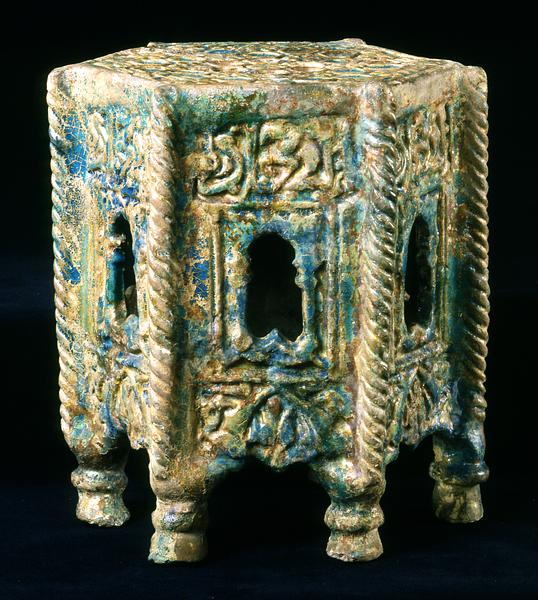Fritware table, molded and covered with an opaque, turquoise glaze
Syria, Raqqa; 13th century
H: 32 cm
Furniture is not common within the Islamic cultural sphere, but a few tables of wood and metal and a number of ceramic tables have been preserved from the Middle Ages. They are often hexagonal and supported a metal tray on which food and drink were served to people seated around it on a rug. Tables of this design were standard fixtures in European smoking rooms in the 19th century.
These tables were often architecturally conceived, and all the sides are identical. The potter consequently needed only one mold, and when dry, the sides were bonded together and covered with a top before they were fired. The inscription over the little arched “windows” reads al-saada (“happiness”).
Inv. no. 21/1982
Published in:
Art from the World of Islam. 8th-18th century, Louisiana, Humlebæk 1987, cat.no. 116;
Kjeld von Folsach: Islamic art. The David Collection, Copenhagen 1990, cat.no.140;
Kjeld von Folsach, Torben Lundbæk and Peder Mortensen (eds.): Sultan, Shah and Great Mughal: the history and culture of the Islamic world, The National Museum, Copenhagen 1996, cat.no. 124;
Kjeld von Folsach: Art from the World of Islam in The David Collection, Copenhagen 2001, cat.no. 201;
Kjeld von Folsach: “A number of pigmented wooden objects from the Eastern Islamic worlds” in Journal of the David Collection, 1, 2003, p. 80, fig. 10;
Margaret S. Graves: “The aesthetics of simulation: architectural mimicry on medieval ceramic tabourets” in Margaret Graves (ed): Islamic art, architecture and material culture: new perspectives, Oxford 2012, fig. 16, p. 75 ;
Alexander Schubert (ed.): Richard Löwenherz: König - Ritter – Gefangener, Historisches Museum der Pfalz Speyer, Regensburg 2017, cat.no. 78;
Margaret S. Graves: Arts of allusion: object, ornament, and architecture in Medieval Islam, New York 2018, fig. 3.6, p. 105;
